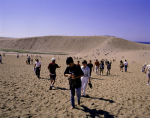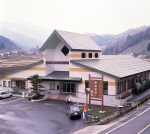Sightseeing
| Sightseeing Spots in and around Tottori City | |
 |
(1) Tottori Sand Dunes (Tottori City) Stretching 16km from east to west and 2km from north to south, the Tottori Sand Dunes are Japan's largest dunes. The hilly terrain offers many scenic features unique to sand dunes such as the 47m high Umanose ("Horseback") dune, the delicate Fumon patterns (sand ripples formed by the wind) or the huge Suribachi depression. map |
 |
(2) Jinpukaku Mansion and Tottori Castle Ruins (Tottori City) The Jinpukaku Mansion is a beautiful French Renaissance style mansion built to accommodate Emperor Taisho (then still Crown prince) during his visit to the Sanin Region in 1907. Behind the building lie the ruins of Tottori Castle, which was the home/headquarter of the feudal lords of the Tottori domain. Although most of the castle was taken down during the Meiji period (mid 19th ? early 20th century) one of its gates (sanmon) and part of the beautiful stone walls still remain today. The area around Jinpukaku Mansion and Tottori Castle with its many cherry trees is a popular spot for viewing cherry blossoms in spring. Next to the castle ruins is the Tottori Prefectural Museum, which displays many art objects and historic relics related to Tottori. map |
 |
(3) Tottori Hot Spring (Tottori City) Although Japan is known to have many hot spings, Tottori Hot Spring is unique in that its water source is in the middle of the city. You can enjoy the hot spring water in a number of hotels, Japanese guesthouses (ryokan) and public baths (sento). map |
 |
(4) Yoshioka Hot Spring (Tottori City) Yoshioka Hot Spring is a quiet hot spring village situated in mountains south of Koyama Pond. This hot spring is said to have been discovered about a thousand years ago. Every year in June, more than 20,000 fireflies flying over a nearby river provide a remarkable sight. map |
 |
(5) Hakuto Beach (Tottori City) Once upon a time, a white rabbit lived near the Hakuto Beach. One day the white rabbit was washed away by a flood to an offshore island. Thinking hard as to how to get back to the beach, the white rabbit said to the sharks swimming around, "Let's compare the number of my friends with yours! Form a line toward the beach." Then, the white rabbit started to walk on the sharks' backs counting the number of them. Right before getting to the beach however, the white rabbit blurted out "I just wanted to get back to the beach". The sharks became angry and stripped the skin and fur of the white rabbit. While the white rabbit is crying in pain, some men on their way from Shimane to Tottori passed by and said to the white rabbit "Wash your body with sea water and dry it". The white rabbit did exactly what they said and naturally, it gave the rabbit more pain. After that, Daikoku-sama, the brother of the men passed by and said to the white rabbit “Wash your body with fresh water and roll on the fluff of cattails”. The w hite rabbit followed his advice and got well at last. The Hakuto Beach is the stage of this story Inaba no Shiro Usagi ("The white rabbit of Inaba") which has been recorded in Japan's oldest written record “Kojiki” The beach is a famous spot for beautiful sunsets and attracts a lot of sea-bathers in the summer. map |
 |
(6) Tottori Karo and Minato Oasis (Tottori City) Minato Oasis was opened in 2004 and incorporates the Tottori Port, an important part in the Eastern part of Tottori Prefecture, and the surrounding area of the Karo Port, a historic fishing port to form/become a center of marine resort. With the crab aquarium "Kanikkokan", the Karoichi fish market and restaurants this area provides ample opportunity for entertainment. map |
 |
(7) Tottori Shan-Shan Festival (Tottori City) The Shan-Shan Festival is the largest festival in the eastern part of Tottori Prefecture. It is held each year on the second Saturday of August and features 3,500 people performing the rain dance “Inaba no Kasa Odori” (umbrella dance of Inaba), a traditional dance of this region. map |
 |
(8) Kannon-in Garden (Tottori City) This garden was built in the mid 17th century. It incorporates the mountain forest behind as its natural background, a style called Shakkei, or "borrowed scenery". Walking around the pond in the middle of the garden lets you appreciate best the beauty of the garden. In 1937 Kannon-in Garden was designated as a national scenic spot. map |
 |
(9) Ochidani Park (Tottori City) The Ochidani Park is located next to Ochidani Shrine, which was built in 1650. The park is designed as a forest park with Japanese plum trees (ume), azalea and maple having been planted there. Recently, a citizen group has bred fireflies in the park and it has since become the most famous spot in the eastern part of Tottori Prefecture for watching the swirling and dancing of fireflies. The best time for viewing is June. map |
 |
(10) Warabekan (The museum of children's songs and toys of Tottori) (Tottori City) The former prefectural library building has been remodeled to become the museum of children's songs and toys. The displays of the world's toys, figures of cartoon heroes, moving toys and the nostalgic wooden elementary school classroom are very popular among both children and adults. map |
 |
(11) Yamabikokan (Tottori City History Museum) (Tottori City) The Yamabikokan introduces the history and culture of Tottori City. It offers a CG reproduction of Tottori Castle and aerial photographs of Tottori City. The museum also frequently holds special exhibitions on the city's history. map |
 |
(12) Koyama Pond (Tottori City) The Koyama Pond is the largest pond in Japan. Aoshima island in the middle of the lake and the lakeside have been developed as a park. map |
 |
(13) Ikeda Clan Graveyard (Tottori City) Many generations of feudal lords from the Ikeda Clan who ruled the Tottori domain are buried here together with their families. The graves of the past lords are unique in that the gravestones are placed on tortoise-shaped stands. This graveyard is of great historic value for preserving the style of graves from the Edo period (17th - 19th century) and has been designated as a national historic site. map |
 |
(14) Inaba-Manyo History Museum (Tottori City) This museum was built in honor of Otomo no Yakamochi, the compiler of the Manyoshu, Japan's oldest collection of poems, and to commemorate the moment when he read the last poem of it here. This museum displays historic relics which evoke the images of the 7th ~ 8th century and introduces folk entertainments passed down in the eastern part of Tottori Prefecture such as the "Kirin-lion Dance" (Kirinshishimai) and the "Umbrella Dance" of Inaba (Inaba no kasa odori). map |
 |
(15) Amedaki Falls (Tottori City) The 40m high Amedaki Falls in the eastern part of Tottori Prefecture provides a beautiful sight and is one of Japan's top 100 waterfalls. There are said to be up to 48 smaller waterfalls further up the mountain. map |
 |
(16) Kawahara Castle (Tottori City) Kawahara Castle is a museum in the shape of a castle keep which introduces the information, history, culture, and nature of Kawahara Town. Erected at a former medieval mountain castle site, it offers a splendid view of the Tottori Sand Dunes and the Chugoku Mountains. The area around Kawahara Castle is designed as a plum-grove park with about 1,000 Japanese plum (Ume) trees. map |
 |
(17) Nagashi-bina at Mochigase (Tottori City) Nagashi-bina is an ancient traditional custom held on the third day of the third month of the old lunar calendar. Although it is the origin of the Japanese Doll festival for girls (hinamatsuri), the tradition has survived in only a few regions today. In Mochigase, people set a pair of paper-made male and female Hina dolls placed on small straw boats afloat on the Sendai River to take away troubles and bad luck. map |
 |
(18) Nagashibina no Yakata (Nagashibina Doll Museumu) (Tottori City) Nagashibina no Yakata is the museum for the traditional Nagashi-bina custom of Mochigase Town. It displays Hina dolls from the Edo period (17th - 19th century) collected from all over Japan. The museum itself is a rare example of large-scale wooden structures built with traditional methods in modern Japan, displaying both grandness and architectural beauty. map |
 |
(19) Saji Astro Park (Tottori City) Saji Astro Park is an astronomical observation facility equipped with Japan's largest reflecting telescope, a planetarium and accommodation facilities.. map |
 |
(20) Kaming Saji (Tottori City) Kaming Saji is a paper-making facility located in Saji Town, one of the homes of traditional Japanese paper (inshu-washi). It produces the largest amount of Japanese paper in Japan, displays and sells artifacts and folk crafts made from Japanese paper and also offers hands-on paper-making classes. map |
 |
(21) Hamamura Hot Spring (Tottori City) This 500 year old hot spring is located only 1km away from the ocean. Its outdoor bath provides a splendid look over the ocean. Hamamura is also the home of “Kaigara-bushi”, a famous Tottori folk song. map |
 |
(22) Shikano Hot Spring (Tottori City) Shikano Hot Spring is a quiet bathing facility located at the foot of Mt. Juboyama. The place of this hot spring is associated with samurai from the 15th and 16th century. A 15 minute walk away from the hot spring lies Shikano Castle Town, which still preserves the atmosphere of the Edo period (17th - 19th century). map |
 |
(23) Shikano Castle Ruins Park and Castle Town (Tottori City) Shikano Castle Town, once ruled by the revered feudal lord Kamei Korenori, still preserves the nostalgic charme of the houses built with traditional construction methods. Although the castle itself no longer exists today, its beautiful stone walls and the many cherry trees make the castle park very attractive, especially in spring, when the cherry trees are in full bloom. map |
 |
(24) Aoya Washi Studio (Tottori City) In Aoya Town, famous for its local Japanese paper (“inshu-washi”), lies the Aoya Washi Studio. Besides conducting paper-making classes this facility also offers courses on Chigiri-e, a collage technique using torn colored Japanese paper, and organizes regular as well as special displays centering on the theme of Japanese paper and light. map |
 |
(25) Uradome Beach (Iwami Town) The Uradome Beach has a beautiful, deeply-indented shoreline stretching for 15km. Together with a marine park, walking trails and cruise ships there are plenty of opportunities to enjoy the beautiful natural scenery. map |
 |
(26) Iwai Hot Spring (Iwami Town) The Iwai Hot Spring is the oldest hot spring in the Sanin Region with a history of over 1,300 years. It is located in an atmospheric hot spring village with many historic buildings. map |
 |
(27) Wakasa Hyonosen Shizen Fureai no Sato (Wakasa Town) Wakasa Hyonosen Shizen Fureai no Sato is a natural park established on the mountainside of Mt. Hyonosen. Equipped with accommodation facilities (Hyota-kun), the natural history museum Hibikinomori and ski slopes this park offers many activity opportunities throughout the year. map |
 |
(28) Chizu-shuku post station and the Ishitani Family Residence (Chizu Town) During the Edo period (17th - 19th century) Chizu-shuku flourished as a post station. The rows of old houses and guideposts still remain today and have been selected as one of the top 100 historic trails of Japan. Among the buildings in Chizu Town there is also the residence of the Ishitani family, an upper class peasant family. It is a modern Japanese building which has received great appreciation for its architectural techniques and interior beauty. map |
 |
(29) Ashizu Valley (Chizu Town) The 4km long Ashizu Valley offers beautiful scenery all year round ? be it the fresh green in early summer, the changing color of leaves in autumn or the snowy landscapes in winter. Camping, hiking, trout fishing, there are many leisure activities to enjoy. map |
 |
(30) Itaibara Settlement (Chizu Town) The Itaibara Settlement still preserves the original scenery of Japanese mountain villages. The streets are only about 2m wide and some of its houses have been built 270 years ago. Although there are some electric power lines for the residents, it feels as if time has stopped in this village. map |
 |
(31) Roadside Station "Seiryu Chaya Kawahara" (Tottori City) The Roadside Station Seiryu Chaya Kawahara on the Route 53 was opened on April 21st, 2006. It overlooks the Sendai River, a famous habitat of carps; and provides a panoramic view of the rural landscape of Kawahara region, where events from the Kojiki, Japan's oldest written record, are said to have taken place. The station includes a restaurant, a convenience store and shops offering local folk crafts and specialties. map |
 |
(32) Roadside Station "Shinwa no Sato Shiro Usagi" (Tottori City) The Roadside Station Shinwa no Sato Shiro Usagi on the Route 9 was opened on April 21st, 2006 It overlooks Hakuto Beach, where the famous myth "The white rabbit of Inaba" (Shinwa no shiro usagi) is supposed to have taken place. The station itself resembles a Shinto shrine and includes a restaurant and shopping facilities for agricultural and marine products. map |
